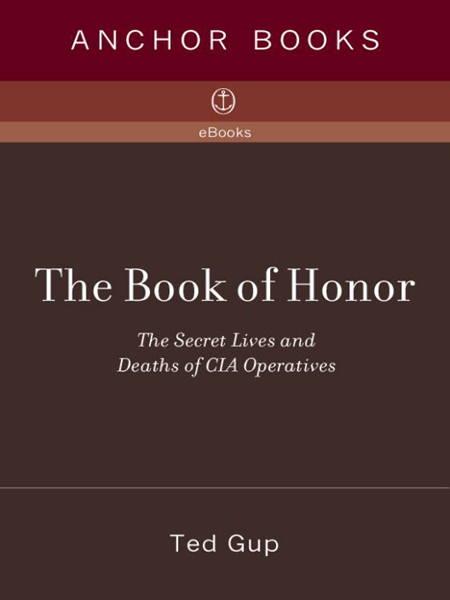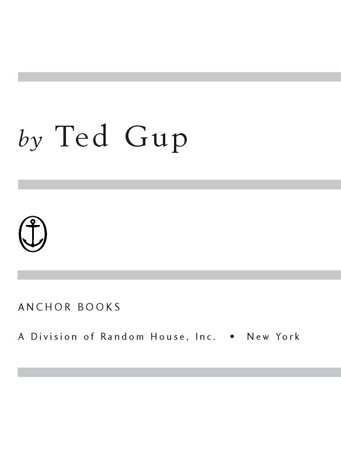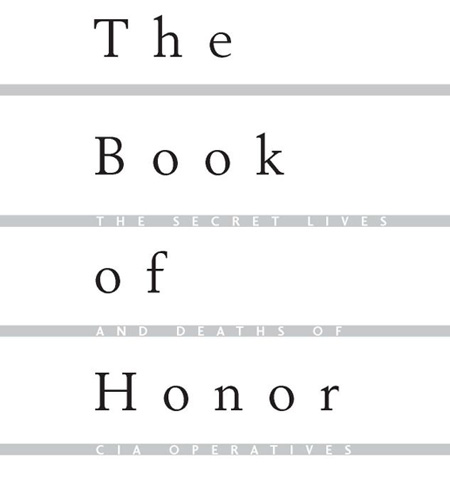The Book of Honor




Table of Contents
CHAPTER 2 - A Pin for St. Jude
CHAPTER 5 - Faith and Betrayal
CHAPTER 9 - Honor and Humiliation
CHAPTER 10 - Privation and Privilege
PART THREE - Chaos and Terrorism
To the sons and daughters of the CIA's stars,
named and unnamed alike,
and in memory of my father,
who told me the only thing a man may hope to leave behind
is his good name.
Acclaim for Ted Gup's
The Book of Honor
“[Gup] puts a human face on the CIA's checkered and often tragic history. . . . Is it possible for a book to have it both ways? Is it possible to criticize an agency for its conduct, its values and ethics, its very view of the world, and at the same time admire and sympathize profoundly with its agents? That seems to be what Ted Gup has accomplished in this very fine and compassionate book.” â
Pittsburgh Tribune-Review
“Ted Gup found out what the Central Intelligence Agency didn't want him to know, and now he's going to tell you.” â
The Plain Dealer
“Told against the backdrop of Cold War and superpower struggles, Gup's sleuthing is a remarkable coup, full of high-level intrigue, cover-ups and drama.” â
Publishers Weekly
“This is not a pretty story. Real espionage never is. What ace reporter Ted Gup found when he researched the CIA wasn't suave James Bonds but lively, complex, and heroic Americans lost in a web of agency coverups . . . [an] astonishing exposé.” â
American Way
Â
Â
Who controls the past controls the future,
who controls the present controls the past.
GEORGE ORWELL
Secrecy, once accepted, becomes an addiction.
EDWARD TELLER, PHYSICIST
Prologue
I REMEMBER
the first time I stood before the Central Intelligence Agency's Wall of Honor. It was during the Gulf War, February 1991. As a reporter for
Time
magazine, I had come to interview an Agency analyst, a specialist on Iraq. The interview was to be on deep background. I was not to reveal the analyst's name or link him to the CIA.
I arrived a few minutes early. The guards at the entrance to the vast 258-acre compound in Langley, Virginia, had been expecting me. They keyed in my Social Security number, issued me a plastic badge, and pointed me in the direction of the headquarters building. Stern-faced guards, a hedge of steel spikes in the roadway, and a landscape bristling with half-concealed monitors encouraged me to stay on course.
I remember entering the Stalinesque headquarters building, some 1.4 million square feet of marble and pillars and row upon row of recessed lights. The lobby was cavernous and cool, almost sepulchral. I had written about the CIA before, but this was my first visit to its headquarters. Set into the floor of the lobby was a huge medallion of the Agency seal featuring a vigilant eagle and a compass rose whose radiating spokes represented the CIA's worldwide reach.
Inscribed overhead, on the south wall, were words from Scripture, John 8:32: “And ye shall know the truth, and the truth shall make you free.” There was no hint of irony about it, though daily, covert officers trained in deception pass through the lobby, their identities a construct of lies intended to produce some greater truth.
It was the north wall, though, that caught my eye. There, rising before me, was a field of black stars chiseled into white Vermont marble. To the left was the flag of the nation, to the right, the flag of the Agency. I drew nearer. Above the stars were engraved these words: “IN HONOR OF THOSE MEMBERS OF THE CENTRAL INTELLIGENCE AGENCY WHO GAVE THEIR LIVES IN THE SERVICE OF THE COUNTRY.”
There were five rows of stars. One by one I counted them. Sixty-nine in all. Below the field of stars was a stainless-steel and glass case. It was locked. Inside was a book.
The Book of Honor, it was called, a tome as sacred to the Agency as if it held a splinter of the true cross. It was a thin volume of rough-cut pages, opened to the center, a black braid, tasseled at the end, tucked into the valley between the open pages. In neat black letters were written the years that each CIA officer died. Beside the year, in some twenty-nine cases, were inscribed the names of the fallen. I recognized two: Richard Welch, gunned down in front of his house in Athens in 1975, and William F. Buckley, the Beirut station chief tortured to death in 1985. His remains were found in a plastic sack beside the road to the airport.
But beside most of the years, there were no names, just stars. Forty nameless stars, tiny as asterisks, each representing a covert officer killed on a CIA mission.
These nameless stars spanned half a century. There was nothing to provide even a hint as to their identitiesâno month or day of death, no country or continent where they fell, and not a word to suggest the nature of their mission. All was veiled in secrecy.
I stood transfixed as scores of CIA employees swept past me on their way to or from the security desk, oblivious to the quiet memorial. In the minutes before my Agency escort arrived to take me to my interview, I took out a notebook and scribbled down the names and dates and stars in the Book of Honor. Who were these stars? I wondered. How and where had they died? What missions claimed their lives?
The first nameless star had died in 1950. What secret could be so sensitive that after five decades his or her identity still could not be revealed? I wondered, too, about the families these covert officers left behind, whether they were free to speak of the loss of a loved one or whether they were forced to grieve in silence. Were they told the truth of what had happened to their husbands or wives, sons or daughters? Did these stars, named and unnamed alike, represent unsung heroes, or were they, perhaps, saboteurs and assassins ensnared in their own schemes? And what, if anything, had the American people been told of these casualties? Had the U.S. government, perhaps the president himself, lied about their fates?
I had seen many such memorials before. The FBI, DEA, State Department, and even Amtrak have memorial walls to those who died in service. But all of these identify their fallen and celebrate their sacrifices. The CIA's is different, a memorial to men and women who are faceless. How, I wondered, could a memorial purport to remember those who are unknown to all but a few? And what sort of person would be willing to make the ultimate sacrificeâthe loss not only of life but of identity as well?
It was that notion of anonymity even in death that moved me. When I had finished jotting down the dates and names and stars, I tore the pages out of my spiral notebook and tucked them into the pocket of my jacket.
I suspected even then that this wall, this Book of Honor, and these nameless stars would stay with me, that I would revisit them again and again until I had unraveled their secrets. But I also knew that scores of Washington reporters, all who covered the intelligence beat, had walked past this same memorial and had similar ambitions. The Book of Honor was one of Washington's most abiding mysteries. There was a reason the secret of the stars remained intact.
A moment later a hand gently tapped me on my shoulder. It was my escort, ready to take me through the security turnstile, and to my interview. As we walked down the corridor, I asked him about the nameless stars. He seemed amused and deftly fended off my question. He had had this conversation before. In my asking, I had revealed that I was a new-comer to the beat.
Later, sitting across from him in a small conference room, I raised the subject once more. “Can't be of much help,” he said, and invoked the CIA's most revered words: “sources and methods.” It is a catchall phrase that encompasses the myriad ways in which the CIA gathers its knowledge of the world. It goes to the very core of the Agency's mission. Identifying the nameless stars, he said, could compromise ongoing operations, expose Americans and foreign nationals to grave risk, and reveal secrets adverse to U.S. interests. In short, it would harm America's national security.
I had been put on notice. The Book of Honor and its nameless stars were not to be trifled with. Any attempt to unmask them would be viewed as a kind of larceny, a theft of the Agency's family jewels.
The inch-thick bulletproof glass and tidy lock that protected the Book of Honor were only tokens of the security that safeguarded the secrets of the nameless stars. A hundred other unseen locks and keys, oaths of secrecy, and cryptonyms stood in my way. I asked my escort about two or three of the named stars. Surely he could discuss those. Wrong.
That evening when I returned home, I slipped the pages from my pocket into a manila folder and scribbled the words “CIA Stars” on the flap. Now and again, in the months and years after, I would pick at the story in my spare time. I made little progress.
Caught up in the press of events, I left the story of the CIA's stars for some indeterminate future. It would be five years before I could devote myself to it fully. I thought that I had been drawn to the story for the sheer journalistic challenge of it. This was, after all, the ultimate secret, the forbidden. I had broken secrets before, some of them extremely sensitive and hard to ferret out.
In 1992, for example, I uncovered the existence of a top secret government installation buried beneath an exclusive West Virginia resort, the Greenbrier. It was there that Congress was to go as a kind of government-in-exile in the event of an impending nuclear war. It had been one of the nation's most closely guarded secrets since its construction during the Eisenhower and Kennedy administrations four decades earlier. My article in the
Washington Post
led to its closure and considerable embarrassment to Congress, which, but for a handful of senior members, had not been deemed trustworthy enough to have been informed of its existence.
That and other stories like it had convinced me that all too often government had used secrecy to conceal a multitude of other sins it did not want to come to light. I had seen how secrets could take on a life of their own. In time, it was not foreign enemies but domestic disclosure that the guardians of those secrets often feared most.
But my fascination with the CIA's Book of Honor went well beyond the mere challenge posed by secrecy. The nameless stars weighed upon me in ways I did not yet understand. I felt a need to restore the names to those marked only by a star. I imagined myself to be their instrument. The notion that such profound individual sacrifice could pass into oblivion disturbed me, doubtless more so than those represented by the nameless stars.
For three years I immersed myself in archival records, death certificates, casualty lists from terrorist attacks, State Department and Defense Department personnel lists, cemetery records, obituaries, and thousands of pages of personal letters and diaries, all in search of the identities of these nameless stars. I interviewed more than four hundred current and former covert CIA officers.
One by one, I learned the names of those behind the stars. But it was their lives as much as their deaths that intrigued me most. In the course of those three years I found myself looking not only into the individual faces of the nameless stars but also into the eyes of the CIA itself. In the aggregate, the stories of the stars form a kind of constellation that, once connected, reveal not only the CIA's history but something of its soul as well.
I am of that generation whose vision of the Agency is clouded by revelations of twenty, even thirty years ago. When I spoke with friends about my efforts to uncover the identities of the nameless stars, more than a few asked me if I feared for my life. They assumed my project would mark me out as a target for domestic surveillance and retaliation.
Their concerns represented a sad commentary on how the public perceives the CIA and, by extension, the tens of thousands of men and women who have worked there over the decades. No other arm of government has so sinister a public image or offers such fecund ground for conspiracy theorists. This is largely the Agency's own doing, part of a legacy that includes historic misconduct and ongoing efforts to prevent that past from surfacing.
But in the public's mind the CIA has always been seen less as an instrument of government than as a mythical creature dwelling among us. We yearn to know its secrets but wince at what they reveal about us as a people and a nation. I tried to draw a distinction between the individual and the institution, believing that what is noble in one can be put to ignoble ends by the other. Whether these stars, named and nameless, are heroes or villains, whether their courage was spent wisely or squandered in folly, is for others to decide. It is enough for me that their names be made known and their stories told.